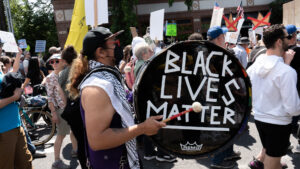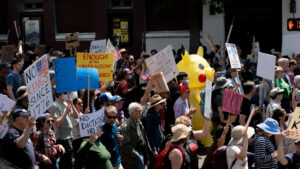Roughly 70,000 protesters joined the No Kings protest in Cal Anderson Park before marching to the Space Needle and finishing at the Seattle Center downtown. Seattle, a city known for its progressive values and history of activism, the No Kings Day protest was about social justice, immigrant rights, and the fight against authoritarianism. The themes of “No Kings” and anti-authoritarianism have naturally lent themselves to criticisms of Trump’s administration, particularly its immigration policies and the actions of ICE.

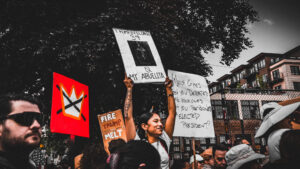
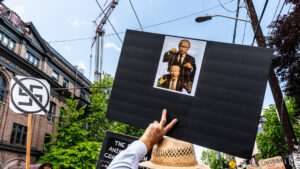
No Kings, No Tyrants: Rejecting Trump’s Authoritarianism
The name “No Kings” is a deliberate call for rejecting traditional forms of power—specifically, authoritarian control. Under the presidency of Donald Trump, these themes gained new relevance as his administration came to represent the embodiment of many of the fears and critiques the protest sought to highlight. Trump’s presidency was marked by divisive rhetoric, policies that often targeted marginalized groups, and actions that were widely seen as authoritarian or anti-democratic. From his attacks on the press and undermining of democratic institutions to his harsh stance on immigration, Trump became a symbol of the very authoritarian systems the No Kings Day protesters set out to protest.
Seattle, with its progressive reputation and history of resistance, became a hotspot for organizing and protest against Trump’s agenda. The No Kings Day Protest, was a place protesters could gather peacefully, express their frustrations, and stand up for their values. As a reflection of this resistance, many parade participants used the event to directly call out Trump’s policies, especially in relation to the treatment of immigrants and refugees.
Trump’s rhetoric on immigration, including the construction of a border wall and the “zero tolerance” policy that led to family separations, inspired protests across the country—and the No Kings Day protests were no exception. It wasn’t just about symbolic opposition to Trump, but also about the very real impact of his policies on immigrant communities, refugees, and families. In the parade, participants carried signs that read “No More Walls,” “Dismantle ICE,” and “Families Belong Together,” echoing national protests and organizing efforts against Trump’s anti-immigrant agenda.
@pnwfoo We out here in Seattle Washington for the No Kings Day and exercising our first amendment right to protest. If you see me say hiiii! . . #chingalamigra #nohumanisillegal #seattlewashington #nokingsinamerica #nokingday
ICE and the Fight for Immigrant Rights
The central focus of the No Kings Day protests was U.S. Immigration and Customs Enforcement (ICE), the federal agency responsible for enforcing immigration laws. Under the Trump administration, ICE became a symbol of aggression against immigrant communities, with increased raids, deportations, and controversial detention practices. The agency’s role in the separation of families at the U.S.-Mexico border sparked outrage, and activists across the nation, including in Seattle, called for its abolition.
Protesters used the first amendment rights to express their anger and frustration with ICE’s actions through powerful visual statements. Protesters had signs with symbolic imagery and direct messages for Trump and his administration, which served as stark reminders of the cruel realities faced by immigrants under Trump’s policies. Others carried banners demanding the end of ICE, echoing the growing call from activists and organizations to abolish the agency entirely, or at least defund it.
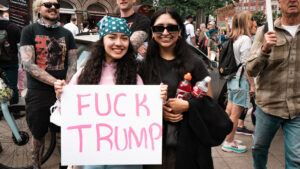
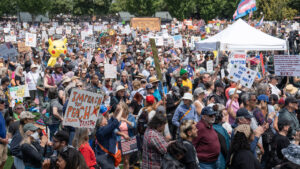
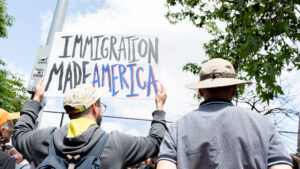
In the wake of Trump’s policies, many Seattle residents felt that the city had a moral obligation to stand up for immigrants. The No Kings Day protest became a space for protestors to demand that the U.S. government recognize the humanity and dignity of immigrants, as well as to challenge the violent tactics used by ICE to enforce immigration laws. The parade’s participants often made the point that the struggle for immigrant rights was a fight for human rights—one that needed to be elevated beyond the rhetoric of nationalism and fear that defined Trump’s administration.
@cosplaysbyshinobi No Kings other than MLK #nokingsday #seattle #pikachu #iceprotest
The Power of Protest Through Art and Expression
One of the most striking features of the No Kings Day protest, especially when protesting figures like Trump and organizations like ICE, is the creative and artistic expression that accompanies the political message. Rather than traditional, confrontational protest methods, the parade’s participants use music, performance, and art to communicate their dissent. Additionally, the protest featured performances and speeches that directly confronted the cruelty of ICE and Trump’s policies. Local musicians, dancers, and activists created a space for creative activism, where political messages were not just shouted, but embodied through art, poetry, and performance. This approach helped transform the event into a celebration of resistance—making clear that protest doesn’t always have to be about anger, but can also be about reclaiming joy, community, and hope in the face of injustice. But to be clear there was anger.
@itsjayfreakinjackson No Kings Day – Seattle, WA – June 14, 2025
Amplifying Marginalized Voices
The No Kings Day protest created an intersectional space for immigrant communities to speak out against the inhumane treatment they faced at the hands of ICE and the broader political system. It was a space for LatinX, Indigenous, and Black communities to share their experiences, raise awareness about the dangers of Trump’s immigration policies, and demand accountability. Seattle’s role as a sanctuary city added another layer of significance to the protests. The city has long been a safe haven for immigrants, offering sanctuary to those at risk of deportation. As such, the parade became both a protest and a celebration of Seattle’s commitment to standing against federal immigration enforcement practices.
The No Kings Day Protest in Seattle was a powerful and vehicle for protesting against the policies of Donald Trump, particularly in relation to immigration and ICE. It was not only an exhibition of political dissent, but a collective resistance against the authoritarian practices that defined Trump’s presidency. By protesting the president and ICE in a joyful, community-centered way, the parade made a statement that resistance doesn’t have to be bleak—it can be empowering, unifying, and artistic. As the U.S. continues to grapple with issues of immigration, human rights, and the legacy of Trump’s administration, events like the No Kings Day protest serve as a reminder of the ongoing fight for justice and equality. The protest’s resistance to Trump and ICE represents more than just a political protest—it’s a powerful affirmation of the values of compassion, inclusion, and respect for all people.
